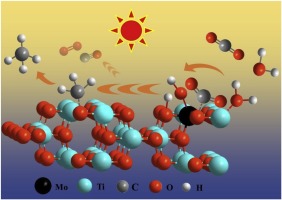Journal of CO2 Utilization ( IF 7.7 ) Pub Date : 2019-12-29 , DOI: 10.1016/j.jcou.2019.12.019 Shuaijun Feng , Jie Zhao , Yujie Bai , Xinxin Liang , Ting Wang , Chuanyi Wang

|
Noble-metal co-catalysis could increase the CH4 product selectivity for photocatalytic CO2 reduction by TiO2. However, the high cost and scarcity of noble metals are key obstacles for their extensive use. Thus, it is necessary to explore cheap alternatives. Herein, Mo-doped TiO2 with different Mo concentrations were successfully prepared via a one-pot hydrothermal method at 473 K. The activity measurements of the photocatalysts show that the CH4 selectivity is increased with the Mo concentrations increasing and reaches 54.1 % at a Mo concentration of about 0.3 wt%. With further increasing the Mo concentrations, the CH4 selectivity begins to decrease. Transient photocurrent and fluorescence emission spectroscopy measurements, IR spectra for adsorbed D2O and ·OH trapping suggest that the promoted electron-hole separation and proton supply are together responsible for the enhanced CH4 selectivity. Moreover, photocatalytic CO, formaldehyde, and methanol reductions with H2O and ·CH3 trapping show that the enhanced CH4 selectivity is not directly related with the interaction of CO2 with catalyst surfaces. These reaction results also imply that photocatalytic CO2 reduction might follow the fast-deoxygenation pathway over TiO2-based catalysts. The present work supplies a guide to explore cheap modifiers for selective photocatalytic CO2 reduction to CH4.
中文翻译:

轻掺杂Mo掺杂的TiO 2的合成,用于选择性光催化将CO 2还原为甲烷:通过Mo掺杂促进H 2 O的离解
贵金属共催化可提高TiO 2还原光催化CO 2的CH 4产物选择性。然而,贵金属的高成本和稀缺性是其广泛使用的主要障碍。因此,有必要探索廉价的替代品。在此,通过一锅水热法在473 K下成功制备了不同Mo浓度的Mo掺杂的TiO 2。光催化剂的活性测量表明,随着Mo浓度的增加,CH 4的选择性增加,并在5 ℃时达到54.1%。 Mo浓度为约0.3重量%。随着Mo浓度的进一步增加,CH 4选择性开始降低。瞬态光电流和荧光发射光谱测量,吸附的D 2 O和·OH俘获的红外光谱表明,促进的电子-空穴分离和质子供应共同促进了CH 4选择性的提高。此外,用H 2 O和·CH 3捕集光催化还原CO,甲醛和甲醇的过程表明,提高的CH 4选择性与CO 2与催化剂表面的相互作用并不直接相关。这些反应结果还暗示,光催化还原CO 2可能遵循TiO 2上的快速脱氧途径。基催化剂。本工作提供了指导,以探索用于将光催化CO 2选择性还原为CH 4的廉价改性剂。


























 京公网安备 11010802027423号
京公网安备 11010802027423号